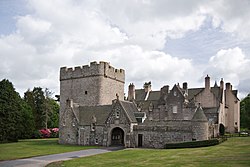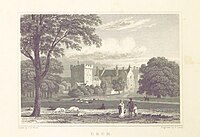Drum Castle: Difference between revisions
No edit summary |
mNo edit summary |
||
| Line 17: | Line 17: | ||
'''Drum Castle''' is a castle near [[Drumoak]] in [[Kincardineshire]]. For centuries it was the seat of the chief of Clan Irvine. The name 'Drum' is derived from the Gaelic ''druim'', meaning 'ridge'. | '''Drum Castle''' is a castle near [[Drumoak]] in [[Kincardineshire]]. For centuries it was the seat of the chief of Clan Irvine. The name 'Drum' is derived from the Gaelic ''druim'', meaning 'ridge'. | ||
The castle is to be found six and a half miles north-east of [[Banchory]] and three miles west of Peterculter. | The castle is to be found six and a half miles north-east of [[Banchory]] and three miles west of [[Peterculter]]. | ||
The property is now owned by the [[National Trust for Scotland]] and is opened to the public. | The property is now owned by the [[National Trust for Scotland]] and is opened to the public. | ||
==History== | ==History== | ||
The original 13th-century tower of Drum Castle has been suggested as the work of | The original 13th-century tower of Drum Castle has been suggested as the work of mediæval architect Richard Cementarius, who built the [[Brig o' Balgownie]], the first Bridge of Don, in Old Aberdeen. It is believed to be one of the three oldest tower houses (and notably unaltered). A large wing was added in 1619 by the 9th laird, and further alterations were made during the Victorian era. | ||
The castle and its grounds were granted to William de Irwyn in 1323 by Robert the Bruce, and remained in the possession of Clan Irvine until 1975. William de Irwyn (of the Irvings of Bonshaw clan) was armour bearer/secretary (and neighbour) to King Robert the Bruce. In June 1636 Sir Sir Alexander Irvine of Drum and his wife Magdalene Scrimgeour were censured for harbouring the outlaw Gilderoy.<ref>William Fraser, ''The Chiefs of Grant'', vol. 3 (Edinburgh, 1883), pp. 62-3.</ref> Drum played a role in the Covenanting Rebellion (as did nearby [[Muchalls Castle]]) leading to its being attacked and sacked three times. | The castle and its grounds were granted to William de Irwyn in 1323 by Robert the Bruce, and remained in the possession of Clan Irvine until 1975. William de Irwyn (of the Irvings of Bonshaw clan) was armour bearer/secretary (and neighbour) to King Robert the Bruce. In June 1636 Sir Sir Alexander Irvine of Drum and his wife Magdalene Scrimgeour were censured for harbouring the outlaw Gilderoy.<ref>William Fraser, ''The Chiefs of Grant'', vol. 3 (Edinburgh, 1883), pp. 62-3.</ref> Drum played a role in the Covenanting Rebellion (as did nearby [[Muchalls Castle]]) leading to its being attacked and sacked three times. | ||
Latest revision as of 17:38, 20 October 2024
| Drum Castle | |
|
Kincardineshire | |
|---|---|
 Drum Castle | |
| Type: | Tower house |
| Location | |
| Grid reference: | NJ795005 |
| Location: | 57°5’42"N, 2°20’17"W |
| Village: | Drumoak |
| History | |
| Built 13th Century | |
| Information | |
| Owned by: | National Trust for Scotland |
| Website: | Drum Castle |
Drum Castle is a castle near Drumoak in Kincardineshire. For centuries it was the seat of the chief of Clan Irvine. The name 'Drum' is derived from the Gaelic druim, meaning 'ridge'.
The castle is to be found six and a half miles north-east of Banchory and three miles west of Peterculter.
The property is now owned by the National Trust for Scotland and is opened to the public.
History
The original 13th-century tower of Drum Castle has been suggested as the work of mediæval architect Richard Cementarius, who built the Brig o' Balgownie, the first Bridge of Don, in Old Aberdeen. It is believed to be one of the three oldest tower houses (and notably unaltered). A large wing was added in 1619 by the 9th laird, and further alterations were made during the Victorian era.
The castle and its grounds were granted to William de Irwyn in 1323 by Robert the Bruce, and remained in the possession of Clan Irvine until 1975. William de Irwyn (of the Irvings of Bonshaw clan) was armour bearer/secretary (and neighbour) to King Robert the Bruce. In June 1636 Sir Sir Alexander Irvine of Drum and his wife Magdalene Scrimgeour were censured for harbouring the outlaw Gilderoy.[1] Drum played a role in the Covenanting Rebellion (as did nearby Muchalls Castle) leading to its being attacked and sacked three times.

In the 19th century, it was the home of Alexander Forbes Irvine of Drum FRSE (1818-1892).[2] He had inherited the estate in 1861, on the death of his father. In 1875/1876, he arranged for a restoration of the courtyard, and the addition of an arched entrance and angle tower. He was also partly responsible for a restoration of the chapel.[3]
There was an older church located here; it was modified to create the chapel in the 1500s and 1600s. In 1857, the west window was enlarged and the cross was added; a new roof was also installed and some restoration of the interior was completed.[4][5]
The site was once served by Drum railway station on the Deeside Railway. Service was discontinued in 1951.
Recent status
The castle is a Category-A Listed property. The report states that the agreement with the National Trust was made in 1964 by Mr H.Q. Forbes Irvine, the 24th Laird, and that the agreement came into force in 1976, after 650 years of ownership by the Irvine Lairds. The summary states that the tower was built in 1280–1300, that the Jacobean Wing was added in 1619 and that modificants were made ca. 1800, 1840 and 1875. The Chapel is Category-B Listed as are the Walled Garden and East Lodge; in 1987, the garden was "derelict".[6]
The chapel, dining hall and estate may be hired for weddings and corporate functions.
The grand Victorian library with over 4,000 books was one of the attractions; the castle was also offering a "programme of temporary exhibitions throughout the year".[7][8]
The castle, gardens and estate are opened to visitors throughout the year.[9] During 2019, 47,446 people visited the castle.[10]
Area's ancient history
Prehistoric habitation of the local area is known through archaeological sites such as Balbridie. Roman legions marched from Raedykes to nearby Normandykes as they sought higher ground evading the bogs of Red Moss and other low-lying mosses associated with the Burn of Muchalls. That march used the Elsick Mounth, one of the ancient trackways crossing the Grampian Mountains; the situation of the Elsick Mounth terminating at a ford to the River Dee is thought to have been instrumental in the strategic siting of Drum Castle as a point to monitor traffic on the Elsick Mounth[11] lying west of Netherley.
Gallery
-
The Rose Garden at Drum Castle
-
Walled Garden, Drum Castle
-
Gateway of the Walled Garden at Drum Castle
-
North-East corner of the Walled Garden at Drum Castle
-
Southern boundary of the Walled Garden at Drum Castle
-
Drum Castle Chapel
-
Drum Castle chapel Interior & Altar
Outside links
- Drum Castle at National Trust of Scotland
- Summer Snow - Cottonwood tree at Drum Castle - YouTube
- of Drum Castle and chapel - YouTube
- 360 Virtual Tour of Drum Castle Grounds
References
- ↑ William Fraser, The Chiefs of Grant, vol. 3 (Edinburgh, 1883), pp. 62-3.
- ↑ "Alexander F-I 20th Laird of Drum". https://www.geni.com/people/Alexander-F-I-20th-Laird-of-Drum/6000000017361052296.
- ↑ Drum Castle Chapel
- ↑ Drum Castle, Chapel - Listing detail (Historic Environment Scotland)
- ↑ Drum Castle Chapel
- ↑ Drum Castle - Listing: Inventory of Gardens & Designed Landscapes
- ↑ Drum Castle
- ↑ Drum Castle Highlights
- ↑ Drum Castle, Garden and Estate
- ↑ "ALVA - Association of Leading Visitor Attractions". https://www.alva.org.uk/details.cfm?p=423.
- ↑ Megalithic Portal: Elsick Mounth






